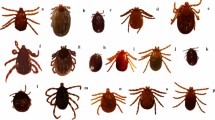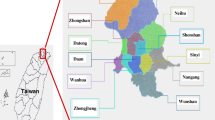Abstract
Between 1993 and 1995, we examined 1742 dogs at two veterinary clinics in Cuernavaca City in Mexico for the presence of Rhipicephalus sanguineus ticks. The overall tick infestation prevalence was 20% and there were no significant differences (p > 0.05) between different years. The prevalence was somewhat higher in spring, summer and autumn (20% or more) than in winter (13.7%). A positive correlation (p < 0.01) was found between prevalence of ticks and rainfall in spring, summer and autumn, whereas in winter there was only a correlation with temperature. Different stages of the tick were found and it was calculated that 2.5 generations could be completed each year. It is concluded that the enviromental conditions of Cuernavaca City favour development and maintenance of R. sanguineus ticks throughout the year and that its role as a vector of diseases poses a threat to dogs and may have potential zoonotic risks. © Rapid Science Ltd. 1998
Similar content being viewed by others
REFERENCES
Ewing, S.A. 1969. Canine ehrlichiosis. Adv. Vet. Sci. Comp. Med. 13: 331–353.
Gilot, B. 1984. Biologie et écologie de Rhipicephalus sanguineus (Latreille,1806) (Acariens, Ixodoidea) dans le sud-est de la France. Sci. Vet. Med. Comp. 86: 25–33.
Gilot, B., Laforge, M.L., Pichot, J. and Raoult, D. 1990. Relationships between the Rhipicephalus sanguineus complex ecology and Mediterranean spotted fever epidemiology in France. Eur. J. Epidemiol. 6: 357–362.
Harwood, J. and James, M.T. 1979. Entomology in human and animal health. McMillan Co., USA.
Pegram, R.G., Keirans, J.E., Clifford, C.M. and Walker, J.B. 1987. Clarification of the Rhipicephalus sanguineus group (Acari, Ixodidae). II. R. sanguineus (Latreille, 1806) and related species. System. Parasitol. 10: 27–44.
Principato, M., Di-Giuseppe, S., Camerlengo, L. and Liottier, B. 1989. Etude preliminaire sur la distribution saisonniere de certains ixodidae (Acarina,Ixodoidea) d'intérêt sanitaire dans la province de Perouse (Italie Centrale). Bull. Soc. Franc. Parasitol. 7: 269–276.
Shortt, H.E. 1973. Babesia canis: the life cycle and laboratory maintenance in its arthropod and mammalian hosts. Int. J. Parasitol. 3: 119–148.
Stella, E., Khoury, C., Damato, F.R. and Rivosecchi, L. 1988. Nuovi dati sulla biologia di Rhipicephalus sanguineus (Ixodidae) nella periferia di Roma. Riv. Parasitol. 5: 3–12.
Author information
Authors and Affiliations
Rights and permissions
About this article
Cite this article
Cruz-Vazquez, C., Garcia-Vazquez, Z. Short Communication Seasonal distribution of Rhipicephalus sanguineus ticks (Acari: Ixodidae) on dogs in an urban area of Morelos, Mexico. Exp Appl Acarol 23, 277–280 (1999). https://doi.org/10.1023/A:1006075232455
Issue Date:
DOI: https://doi.org/10.1023/A:1006075232455




